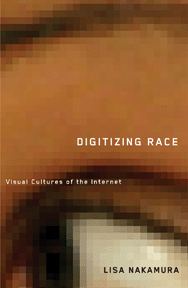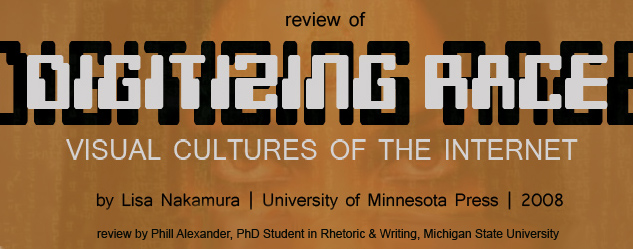

Introduction:
Digital Racial Formations
Chapter 1:
"Ramadan is Almoast Here"
Chapter 2:
Alllooksame
Chapter 3:
The Social Optics of Race
Chapter 4:
Avatars and Visual Culture
Chapter 5:
Measuring Race on the Internet
Epilogue:
Racio-Visual Logic
Conclusions on Digitizing Race
Thus Instant Messenger is a communicative practice with an avatar culture that needs to be discussed quite differently from earlier ones, like MOOing and chatting, since it is part of a social network that is founded on prior offline relationships. (p. 49) In chapter 1 of Digitizing Race, Nakamura looks at how users utilize Buddy Icons in Instant Messaging to express gender, racial, and religious identity. Like her introduction, Nakamura once again offers a fantastic review of existing literature, touching on studies of the gaze (continued from the introduction) and developing the seemingly separate theories that govern the study of creation of visual/video content in online spaces and the use of textual communication (quickly charting the history from UNIX talk and IRC to AOL’s Instant Messenger). The meat of Nakamura’s argument here is that because users can create their own IM “buddy” images (small image files that sit in the IM window, next to a user’s textual messages), these are places for individual identity formation. She continues to assert that individual users, unlike corporations like AOL who provide IM, will engage issues of race in their buddy icons, which they view more as accessories for their friends to see than as faces they’d present to strangers. Hardcore chat/IM users might balk at some of Nakamura’s statements (I know those, for example, who would argue with her generally astute observation that IM is based on pre-existing offline relationships), but her overview of how IM is used and has evolved is useful for those who aren’t users or are infrequent users. This chapter works well, but one of the limitations of print plagues Nakamura’s examples. She refers to the way the sequence of frames in a buddy icon can mimic the camera, but when witnessing those stills reconstructed into a whole—as they appear on the page in the book—the movement she speaks of cannot be witnessed.
from www.buddyicon.info |